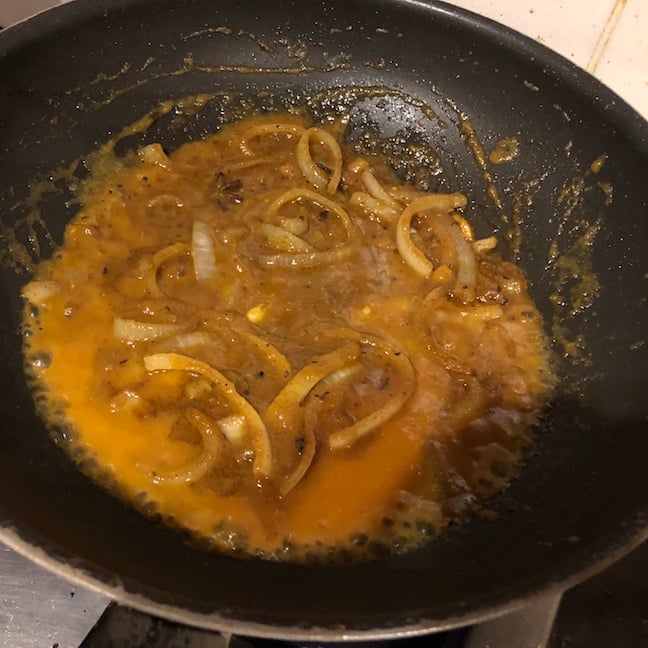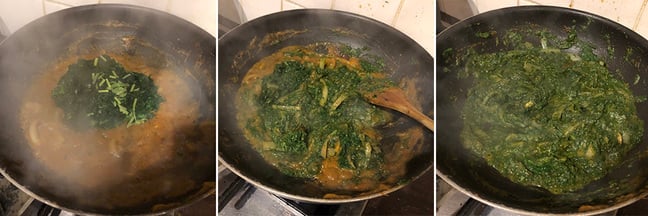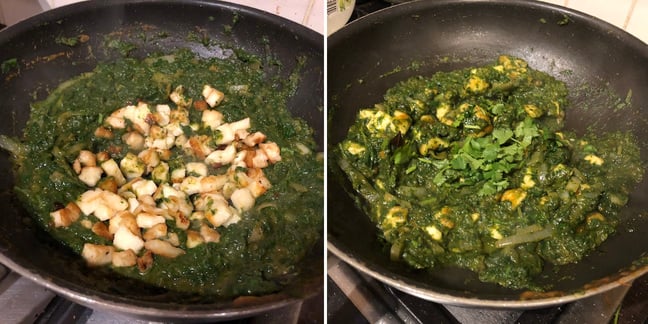This article is more than 1 year old
The Great British Curry: Put down the takeaway, you're cooking tonight
Yes, while half-sauced yourself...
Post-Pub Neckfiller The late and much-missed Lester Haines wrote a series called Post-Pub Nosh Neckfiller, high calorie food you can cook when drunk, or hungover. These veered into sophisticated recipes hard to rustle up when sober, let alone drunk - like home made polenta Eggs Benny with home made hollandaise sauce.
As a tribute, and for one night only, we’re reviving this. Why? Because you’ll by now be drunk, hopefully, and thoroughly fed up with Christmas food.
The “BIR” (British Indian Restaurant) curry sounds daunting but cheerfully fulfills the criteria. It’s extremely quick to cook - quicker than waiting for a takeaway - and has the kick you need. Our example revisits ground Lester once described - the difference being what you learn here can serve as the basis for dozens of late-night dishes that are ready almost instantly and have that curry house taste.
The Recipe
The BIR curry is one of those dining staples that remained a mystery for years, but inevitably with the internet secrets get out. It’s actually pretty simple too, although the key element needs preparing in advance. I have cooked this as an alternative to the “kebab on the way home” and never once regretted it. If your base gravy is ready (or thawed out) it takes less than 10 minutes. I wish the secret had got out earlier.
I’ll admit that this is a simplified version of a recipe that will horrify fans of Indian food. It may even horrify “BIR" purists who already know this method. But Lester’s rules must be observed: this must be completed quickly when not entirely sober. Alongside the rough and ready version, there’s advice on making a slightly more sophisticated one for an evening meal. Drunks are served first.
The principle is simple: caramelised onions. A curry starts with an extremely hot oil in which to fry the spices, to which you add a foul slop - the onion masala or “base gravy” - which is then blasted away by the heat. Then this almost ready for anything, usually a specific blend of spices and pre-cooked meats to create the familiar menu meal. (In reality, restaurants have their own house blend of spices which they introduce to the masala first (which is why so many establishments taste the same), then they add the blend for the dish they’re cooking, eg Jalfreizi, Bhuna, etc)
Ingredients
The only ingredient you may struggle to find here is garlic and ginger paste. This is internationally classified as a noxious substance - you will have seen the hazard markings on lorries and wondered what they’re about. Well now you know.
Unfortunately, you’ll need a lot of this for these recipes, and it is mandatory. (You can put ginger and garlic in a blender of course with some oil, but that’s beyond the bounds of the project here). Fortunately, the stuff is not expensive, at around £1.20 a jar. I would also recommend you get fistfuls of fresh coriander from a corner shop or market, and avoid the prissy and anaemic coriander sold by supermarkets in thin plastic bags.
The hangover-forestalling carb accompaniment might surprise you: it’s plain old pita bread. But the Karachi natives I know - where the really great stew curries like Nihari come from - have pita with most of their home cooked specials. I have never found making my own naan breads particularly worthwhile, and I have included a basmati rice side for people who want to eat their curry sober, or aren’t in a rush, or are veggie.
I’ll save the Bit You Must Do First until last, to show how easy it is. This will take about 10 minutes.
Saag paneer
This requires very hot oil and very intense heat, so don’t be stupid and scar yourself for life. And if you do, we don’t want pictures.
The quantities here are sufficient to feed two very gluttonous people and three good-sized (British, not American)-sized portions. As a side-dish this will feed four. I will assume you have about half a pint of masala or so, some 350ml, on hand – recipe below. And for the drunken version, you can get by with garam masala and madras powder.
I am not kidding: the caramelised gravy carries all before it. For something with a bit more subtlety use cardamom seeds and cumin seeds, and even a star anise to sweeten it a bit. But you can actually get away with just a dash of madras powder in the oil.
Many if not most saag recipes call for tomatoes, and many omit the onions. I disagree, finding the tomatoes completely missable in this dish (it’s 11pm, why would you miss them?), while the onions help to bind it together - otherwise it’s a paste. The onions also help sweeten it.
The heat generated is the key to the magic that happens next, which is why restaurants and proper chefs use a metal frying pan. Trust me, you don’t need one, so long (and this is important) as you can generate enough heat. Unless you’re cooking for one and are on a diet don’t bother with a normal sized frying pan, it doesn’t have the space you need. Also, it’s essential that you warm the gravy up a bit, otherwise the first dollop will cool the pan and it won’t work: you’ll have a spicy boiled soup. 45 seconds in the microwave should do it.
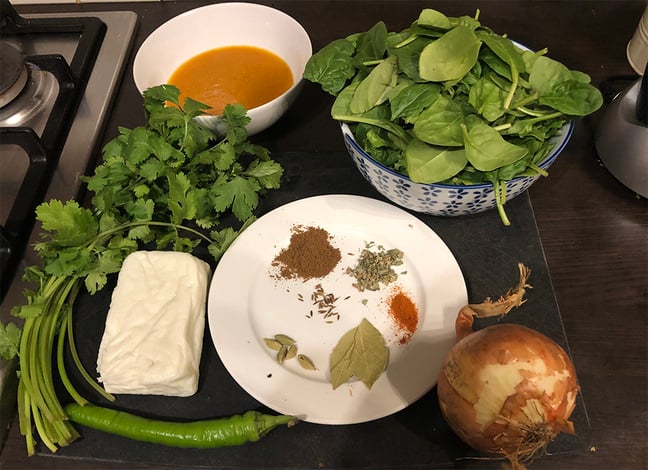
The ingredients. Not shown: oil, salt, lemon juice (optional). If stuck you can get by with Madras Curry Powder - seriously. (Click to enlarge.)
I warned you this isn’t for purists. Here I am using halloumi cheese instead of paneer. Why? It’s a lot easier to find and works fantastically well. I challenge most people to tell the difference sober, let alone after visiting the pub. (As an aside, a curd-based cheese is pretty trivial to make yourself.)
For spinach, I prefer the older, leathery kind, which you can chop into inch-wide strips and blanch for a minute, no more. The very popular but tasteless baby spinach – seen here – just needs a splash of water and a few seconds. There’s no need to chop this at all. Frozen spinach works well.
(In North London it’s compulsory to use organic kale and the police may issue you with a caution for using industrial spinach. Only joking.)
Once splashed, press it right down, and it will do that amazing spinach disappearing trick. Whatever spinach you’re using, wring as much water as you can out of the blob, by hand works best.

Use a hand blender to get it into the texture you want. Some people like a completely smooth sinister-looking paste, but not me.
You can stop here and keep it in the fridge for later if you’re going out.
Having drained it as well as you can muster, now chop about two-thirds of the coriander coarsely and blend it with a hand-blender. You’re wondering how on earth you’ll feed people with that measly bit of spinach - but fear not.
Now slice half the onion thinly, and cube the cheese. It needs a minute on two sides to give it that toasted look 'n' feel. You can cheat by chopping it up into spam fritters then slicing these again sideways, rather than trying to examine and turn each one individually - a tricky manoeuvre when drunk.
As this is frying, chop the final third of your coriander bunch finely - the flavour is in the stalks remember.

Halloumi works just as well as paneer cheese. And (right) remember to warm the gravy up before using it.
In your "very big frying pan”, dry-roast some whole spices (for the posh version). Add the oil and make sure it’s up to a good heat and add the powdered spices for about 20 seconds.
Then add the onions and give them a minute – not too long. This is accelerated cooking. The heat should now be really intense.
Now for the fun part.
Start to dollop in the gravy at the side of the pan or wok, ladle by ladle. It should instantly be scalded, turning from light to a darker colour.
It is now acquiring that rich, glossy look of a professional Indian meal. The dish can then go in any number of directions – for a meat curry you would here add the precooked meat for example, or some boiled spuds for saag aloo.
Once you’ve got three or four ladles of your gravy in, you can gradually add in the spinach – turning it over.
Only a tiny amount of spinach will turn a sea of brown gravy intensely green. Some swear by a dash of lemon to keep the colour, but you can add this at the end or not at all. I’ve never found the colour a problem – look at it.
Remember you’re just stirring it, not cooking it, and it’s almost done. With a minute to go you might want to add a half teaspoon of sugar if you think it’s too bitter - or a pinch of methi leaves for some body. Add the cheese, just for a minute and warm it through. Finally add the rest of the coriander and stir that through.
It’s ready. Serve it up with the pita bread.
Sorry, there’s no final "presentation photo" in a fancy dish. Or attractive people enjoying it. (I admit there should be to be Neckfiller compliant.) I was hungry and ate it. You will want to too.
The bit you must do first, at last
Al's Kitchen also does a very credible British Indian Restaurant "base gravy"
Here we have: big onions, garlic and ginger paste, tomatoes, bit of old cabbage, turnip.
The masala slop or base gravy can be prepared in advanced and frozen, and is much less daunting than it seems, and simpler than many of the recipes dictate. You just need need lots of onion, the G&G paste - a lot of it - a tin of tomatoes and some spices. This you then boil for an hour and a half, then blend with an electric hand blender.
Some insist on cooling it to room temperature before blending - I wouldn’t bother.
One thing I like about this is that it benefits from the leftover stuff that gets forgotten about at the bottom of the fridge: carrot, a bit of cabbage, even a bit of turnip or parsnip. And the same applies to things at the back the spice drawer. Most recipes call for red pepper, but you can completely dispense with this, I’ve found.
Here you can throw in some pungent stuff that hasn’t been used for ages or you wonder why you ever bought it in the first place, like mace or cinnamon. But even curry powder will do. Into the pot use somewhere between a teaspoon and a tablespoon each of garam masala, paprika, cumin powder, turmeric and stir. Much more sophisticated versions can be found online (links below).
I strongly recommend going for the largest onions you can find - three huge Spanish onions will be sufficient for several meals, and are easier to chop up roughly with a meat cleaver. This dispenses with the most tedious part, peeling and chopping lots of onions. And don’t even bother frying them, as you should if you were in a genuine British Indian.
Even manky old winter root vegetables give it a really diabolically good depth. All of these can be roughly chopped as you’re boiling it down to a slop. Throw in the tomatoes, half of the G&G or more, and cover them and leave to simmer for 75 to 90 minutes. Drain slightly and leave it to cool.
After blending the pot, what you’re left with is a kind of soup that nobody would ever want to eat, one that is strangely tasteless. Although as the Red Army fought the Wehrmacht across the 2,000 mile of Russian steppe, they would have considered this a feast in itself.
For proper recipes. Al’s revised one* looks pretty silky and I look forward to trying it. Here's another.
What about us meat eaters?
Post-pub nosh without meat? Are you mad? No I’m not trying to convert you either. But meat requires another step of preparation. BIRs use a pre-cooked chicken, lamb or beef which his really just pre-boiled meat in a nice spicy stock. Beef needs softening up, but lamb doesn’t so much. Here’s Dan Toombs version*.
My tip would be to leave the onion slices very large, or chopped absolutely tiny, as you’ll be lifting the meat chunks from the stock and it’s really tedious to extract sticky onions from the meat. As with the base gravy, make use of the pungent spices like cloves and mace, and Nigella seeds, named after the great TV chef, Nigella Lawson**. If you do go with onions you can blend this and add this to the meat curry, it can be quite sensational.
And double up on the garlic and ginger. Here’s the result of cubed beef given the treatment.
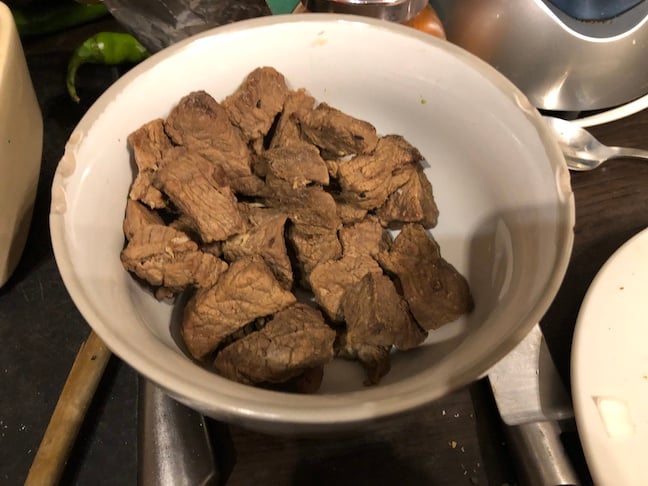
(As if you didn't know what cooked meat looks like.)
Happy eating
You don’t have to be drunk to cook this (although it helps). My freezer always has a couple of tubs of the gravy "for emergencies”. Come home late or knackered and in a few minutes you’ve got a curry better than many takeaways. What’s not to like? ®
*For excellent videos Al's Kitchen YouTube channel has a lot of useful advice and Dan Toombs coffee table books have many more tips and ideas.
** Before anyone sends in a correction, that's also a joke...



